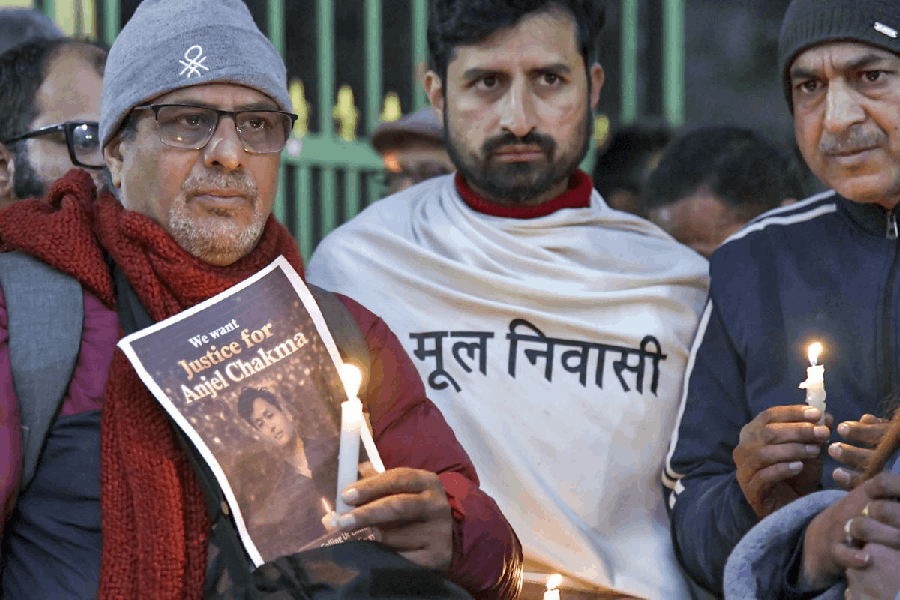 |
 |
| Nandi and (below) Karak |
New Delhi, June 11: A physicist in Calcutta and a graduate student in Bangalore who jointly simulated the solar interior on computers have discovered that the Sun has a short memory — only about five years.
Solar physicist Dibyendu Nandi and PhD student Bidya Binay Karak have shown that the Sun’s memory of its sunspot cycles, long believed to be imprinted in its churning plasma, lasts no longer than five-and-a-half years.
Sunspots are regions of strong magnetic fields that can generate solar storms which spew vast amounts of plasma far into space. These electromagnetic jolts may at times disrupt satellite operations, telecommunications and air traffic over the poles.
The new research implies that long-term predictions of sunspot cycles — a periodic rise and fall in activity — are impossible.
“We’ve identified a mechanism that erases the Sun’s memory,” said Nandi, an assistant professor, and a Ramanujan Fellow at the Indian Institute of Science Education and Research (IISER), Calcutta.
“The memory lasts for less than half the period of a typical solar cycle of about 11 years,” said Nandi, who will present these findings at the annual conference of the American Astronomical Society (AAS) in Anchorage, Alaska.
The frequency of solar storms depends on the strength of sunspot cycles — the greater the strength, the more frequent the storms. The premise of solar memory assumed that the history of sunspot cycles determines the strength of future cycles.
This spawned efforts worldwide to predict the behaviour of future cycles up to a decade in advance — with little success. Forecasts of the current so-called cycle 24 have diverged wildly. Some scientists predicted one of the strongest cycles ever, others predicted a weak cycle, while dozens of research teams came up with intermediate strengths.
A solar cycle prediction panel set up by Nasa and the US National Oceanic and Atmospheric Administration also failed to arrive at an early consensus, and was divided between a very strong and moderate cycle, before it revised its forecast down to a weak cycle.
Astrophysicists use simulations of the solar dynamo -- the interaction of solar magnetic fields and the Sun’s plasma — as a tool to study the origin of sunspot activity. But previous forecasts ignored a process scientists call turbulent pumping.
Nandi and Karak tweaked the solar dynamo simulations by adding the effect of turbulent pumping — the term physicists use to describe the complex and fast flow of hot plasma from the surface of the Sun into its deep interior.
“This flow carries a chaotic feature of the magnetic field from the surface of the Sun into its interior where its future cycles are generated,” said Nandi, who will receive an award — the Karen Harvey Prize — in Anchorage from the AAS solar physics division for his contributions to the study of the Sun. “The transfer of this chaotic feature into the interior erases the memory,” he said.
Karak, who studied BSc at the Bankura Christian College and is now pursuing an integrated PhD at the Indian Institute of Science, Bangalore, spent eight weeks at the IISER, where he was assigned by Nandi to run the tweaked simulations.
“This work is an important addition to the body of knowledge that already exists and will take this field forward,” said Madhulika Guhathakurta, an astrophysicist with the US National Aeronatics and Space Administration and the lead scientist for Nasa’s Living With a Star initiative, an effort to predict solar cycles and their effects on Earth.
“While a full understanding of the solar dynamo requires extremely complicated physics and computer modelling, Nandi and his collaborators are systematically exploring the underlying physics in greater detail, piece by piece,” she said.
Guhathakurta said improved forecasts of solar events would give technology operators time to take pre-emptive steps, such as adjusting power transmission lines to prevent cascading failures.
The new findings suggest that sunspot cycle forecasts would require constant observations of the Sun within a cycle for predictions of the next cycle -- just as weather forecasts on Earth rely on atmospheric observations of one day to predict the next day’s weather.
Karak and Nandi have submitted a paper describing their work to the journal Physical Review Letters. “Reliable prediction of the maximum of solar activity can be made only at the preceding minimum — and for improving accuracy, we’ll need continuous data to account for the Sun’s short memory,” said Karak.
Nandi, 38, has published several papers on solar activity, including one that revealed for the first time why sunspots unexpected disappeared from 2008 and 2010. Petrus Martens, a professor at the Montana State University in the US said he had nominated Nandi for the Karen Harvey Prize for his contributions to solar physics, leadership in the field, and mentoring graduate students.











